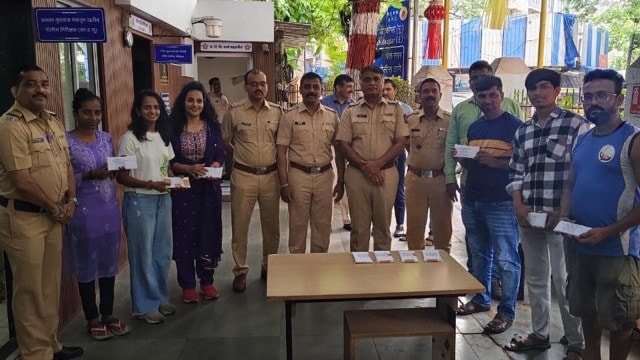Why ‘stolen phones’ are making a beeline to Mumbai police stations
With Mumbai Police placing the return of stolen mobile phones on priority, ramping up and streamlining a unique central registry, stations across the city have been holding “mobile returning functions” every other week over the past three months.
 A ‘mobile returning function’ held at Pant Nagar police station in Mumbai’s Ghatkopar (East). (Express Photo)
A ‘mobile returning function’ held at Pant Nagar police station in Mumbai’s Ghatkopar (East). (Express Photo)There were three courier packets on the table in front of Constable Santosh Gidh at the Pant Nagar police station in Mumbai’s Ghatkopar (East), each containing a mobile phone reported “stolen”. While Gidh waited for their owners to arrive, two others walked in over the next hour, each with a mobile phone they had “picked up by mistake” and now wished to return.
With Mumbai Police placing the return of stolen mobile phones on priority, ramping up and streamlining a unique central registry, stations across the city have been holding “mobile returning functions” every other week over the past three months. The best part, according to senior officers: these phones are being recovered without policemen having to even step out of their stations.
Official data shows Mumbai Police recovered 12,109 mobile phones between September 17, 2019, and June 17, 2025 — around six on an average every day. Since then, between June 18 and August 21, they recovered at least 8,000 mobile phones — 126 on an average per day.
Officers pointed to those two dates, in 2019 and 2025, when asked for a clue.
On September 17, 2019, the Central Equipment Identity Register (CEIR), a Department of Telecommunications initiative to help track stolen mobile phones, was launched. And, on June 18 this year, the Mumbai Police top brass decided to make the recovery of stolen mobiles a priority by implementing a series of measures: streamline the process, involve cyber police and make Deputy Commissioners steer the drive across zones.
“We were of the view that stolen mobile phones affect the common man the most and returning them would create goodwill for the police among the public. Accordingly, changes were made to the process on June 18,” a senior officer said.
When contacted by The Indian Express, Mumbai Police Commissioner Deven Bharti said, “We have prioritised tracing stolen phones and dedicated teams have been put on job in every zone.”
According to senior officers, the CEIR “portal has been there for a few years but the mentality that it was not a priority meant only a few police stations used it… there was a need to streamline the process”.
Explaining how the portal works, an officer said:
* Once the unique International Mobile Equipment Identity (IMEI) number of a phone is entered, and flagged, the SIM is locked and disabled.
* When a new SIM is used, the portal gets a notification.
* The officer in-charge calls on the new SIM, informing that it is a stolen phone.
“Mostly, the user hangs up… In some cases, there is a language barrier as the person answering may be in some other part of the country,” the officer said.
But the next step usually leads to the phone’s recovery.
“The call is followed by an automated message, which informs that if the phone is returned, an offence will not be registered or else the user would be arrested. It also provides the name of the officer at the police station in charge of recovery of mobile phones. It mentions that if the person is outside the city, the phone should be couriered to the police station address,” the officer said.
“Usually, after the message, many call back claiming they had picked up the phone somewhere and kept it since there was no claimant. In some cases, they directly land up at the police station,” the officer said.
For instance, a family of three walked into the Pant Nagar station to meet Constable Gidh and returned a mobile claiming that they took it since no one had claimed it. “We usually ask them a few questions, including their name and address, to check if they have a past record of such crimes. If that is not the case, we warn them not to simply pick up such mobiles in future. After the warning, they are allowed to go and the phone is kept at the police station to be handed over to the complainant,” Gidh said.
Underlining a key factor in such cases, a senior officer said, “The common man is more interested in getting the phone back and not willing to follow up with a formal complaint. And the lure of not having a case registered gets people to return the phone.”
Asked about the portal’s significance, another senior officer said it depends upon how seriously the offence is taken. “Recently, a decision was taken to make one person at every police station in charge of mobile phone retrieval. Further, zonal DCPs are answerable and the Cyber DCP has been made the nodal officer. The entire process is overseen by Joint Commissioner (Crime) Lakhmi Gautam. Now, senior officers ask for regular updates and question police stations if the recovery rate is low,” the officer said.
The bottomline: “Having a dedicated person in charge and constant supervision have made a world of a difference.”







